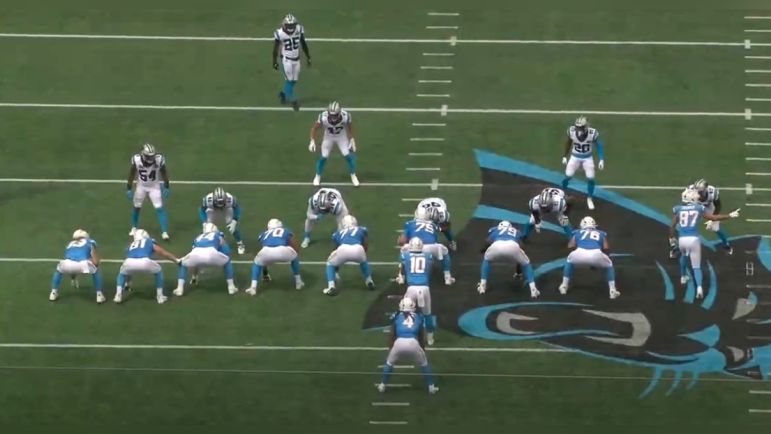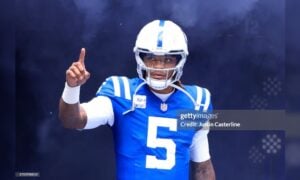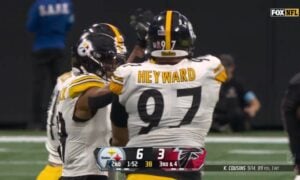As we’ve been doing for many years now, we’ll break down the Pittsburgh Steelers’ opponent each week, telling you what to expect from a scheme and individual player standpoint. Like last year, Josh Carney and I will cover the opposing team’s offense. I will focus on the scheme, Josh on the players.
Today, our scouting report on the Los Angeles Chargers’ offense.
Alex’s Chargers Offensive Scheme Report
Run Game
Under Jim Harbaugh, the Chargers are bringing a Michigan/Baltimore flare. They want to be big and physical and run the snot out of the football. Two games in, the model’s working. The team brought over RBs Gus Edwards and J.K. Dobbins from the Ravens to lead the Chargers’ backfield. Their carries are similar, Edwards with 29 and Dobbins 27. The results are not. Edwards is averaging under three yards per carry while Dobbins is at 9.9, insane even for the small sample size. That number won’t stay so high for long but he’s always been talented and a threat when healthy.
Overall, the Chargers rank second in the NFL in rushing offense with 197.5 yards per game. They had 176 in the opener against the Las Vegas Raiders and 219 in their Week 2 cakewalk against the Carolina Panthers. The Chargers are tied for eighth in runs of 20-plus yards with 10. Dobbins is responsible for seven of them, tied with Jordan Mason and Alvin Kamara for most in the league. The Chargers have run the ball 71 times, sixth-most in football.
Like Pittsburgh, they’re a team that loves using tight ends. Three of them have logged at least 17 percent of the Chargers’ snaps this year. They use a fullback and in another resemblance to Baltimore, they’ve taken DL Scott Matlock and made him a two-way player, No. 44 seeing work at FB and along the d-line. He’s logged 47 offensive snaps through two games. They even used Gus Edwards at FB in front of Dobbins against Carolina that turned into a 40-plus yard Dobbins touchdown run.
They don’t use much of a receiver run game though WR Derius Davis had two carries in Week 1. Both of them came on 1st and 10.
Conceptually, they’ll line up tight looking like Harbaugh’s offenses at Michigan and Stanford. Not too often you can pack all 11 players on the end zone angle.
Their run game is varied and offers anything under (former Ravens) OC Greg Roman. They run inside zone from one and two back. They run Counter Trey. They run Duo. One thing I noticed was their penchant to running to the closed side of the field. They’re not afraid to go that way instead of running to the away hash. Examples.
They will use some pistol with Justin Herbert, and you wonder if his ankle injury will compel them to use more of it to avoid having him get away from center as often.
In the opener, the Chargers were a mess early. Five offensive penalties in the first 20 minutes, including four by the tight ends and another false start by a wide receiver. They cleaned things up against Carolina, but the Pittsburgh crowd noise could present some issues. If I’m Pittsburgh, I might stem/shift the front and have some pre-snap movement to try to bait a player into moving early.
Some other offensive notes. The Chargers have scored 22 and 26 points in their first two games. They’re 10th on third-down conversions at 41.9 percent and 50 percent in the red zone, three-of-six. But those sample sizes are pretty small and difficult to judge. They have turned the ball over twice and sit plus-two in turnover differential.
Passing Game
It is led by Justin Herbert, who is expected to start despite an ankle injury. Like Pittsburgh, Herbert hasn’t had to do a lot his first two games, relying on his defense and run game. Only 46 attempts the first two weeks, just three more than Justin Fields. He’s been efficient with his chances, completing over 67 percent of his throws with three touchdowns and one pick. He’s been sacked twice this year.
After struggling as a rookie, former first-rounder Quentin Johnston leads the way with eight receptions for 89 yards and two touchdowns. Those scores equal the number had had last year. Rookie Ladd McConkey has seven catches for 65 yards and a score while TE Hayden Hurst has three grabs for 38 yards. The Chargers have just two completions of 20-plus yards, the same number as Pittsburgh and Carolina. So it is a shorter passing game.
Off the top, what stuck out was their play-action game on 1st and 10. Often the first play of a drive. Willing to take some chances out of run-heavy looks when the defense is looking to get downhill. Pittsburgh can’t get fooled.
They like using mirrored concepts. Favorite is Hank, which they run out of different looks. But functions the same from empty or condenses. Curl/flats to each side with an OTB (over-the-ball route). Examples.
On third and short/medium (3-6 yards), they like using levels concepts and bumping out No. 3 in short motion to become the new No. 1. Two examples.
Overall, lots of spacing concepts to stretch the field horizontally. But if Herbert sees MOFC, he’ll target his X-receiver vertically.
Los Angeles likes to use crossers and overs/benders in the red zone so the Steelers should play zone to avoid getting picked or out-leveraged in all the horizontal traffic.
Finally, the Chargers had issues picking up twists and stunts. Pittsburgh could lean on those and ILB wrap blitzes more often to try to get free, especially with the Chargers on the road and in greater risk of communication difficulties.
Josh’s Individual Report
It’s Chargers week, Steelers fans!
With that comes the home opener for the 2024 season on the North Shore at Acrisure Stadium in what should be a very physical, old-school, smashmouth football game between two teams built on physicality.
The Chargers have undergone a complete transformation in that department this season after the hiring of former Michigan head coach Jim Harbaugh. After being a high-flying offense in recent years with star quarterback Justin Herbert, the Chargers have shifted to a run-heavy, punishing team that fits Harbaugh’s approach to a T.
While Herbert remains a good quarterback, one who can hit the deep ball consistently, the Chargers run — literally — through the offensive line and a pair of former Baltimore Ravens running backs in J.K. Dobbins and Gus Edwards.
Dobbins has been quite the revitalization with the Chargers, leading the NFL in rushing with 266 yards on 27 carries through the first two weeks of the season.
His vision is outstanding early in the year, and his patience and ability to hold just a tick behind the line of scrimmage and let his linemen open up holes has done wonders for the Chargers’ run game.
Though he has some devastating injuries in his past, including a torn ACL and a torn Achilles in back-to-back seasons, Dobbins looks very healthy. He is firing on all cylinders in Greg Roman’s offense, an offensive scheme he knows well from his time in Baltimore.
Same for Edwards, who is the perfect complementary piece to Dobbins, providing the hammer between the tackles. Gus The Bus isn’t a home run hitter, but he can really wear defenses down and refuses to go down on first contact.
The Steelers know him well and are prepared.
While the Chargers have a punishing 1-2 punch in the backfield, they are a bit light at receiver overall, even after spending a first-round pick in 2023 on Quentin Johnston and a second-round pick on Ladd McConkey in the 2024 NFL Draft.
Johnston had a two-touchdown game against the Carolina Panthers in Week 2 and really seemed to have his coming-out party. He won vertically for his first touchdown and then showed great feel against zone coverage to sit and show Herbert his numbers in the soft spot of the zone.
Consistency catching the ball has always been a concern for Johnston, but there’s no denying the physical traits overall. The Chargers don’t throw the rock much, but if they have to on Sunday, Johnston is the one to watch.
McConkey is a good receiver in the slot. He’s a shifty route runner, one who creates ample separation. He hasn’t been targeted as much as many expected, but he does have one touchdown so far, showing off his elusiveness in the process.
It’ll be curious to see if he’ll be targeted more this week in the slot, most likely against rookie Beanie Bishop Jr. for the Steelers.
Joshua Palmer is the other main receiver for the Chargers, but he’s banged up. Right now, he’s primarily the WR1 for the Chargers. He’s a good possession receiver with consistent hands and is underrated as a route runner.
We’ll see if he can go on Sunday as he’s dealing with an elbow and calf injury and has missed practice Wednesday and Thursday. Former Steelers receiver Simi Fehoko and rookie Brenden Rice and Jaylon Johnson are the Chargers’ other receivers who could get some run on Sunday in Pittsburgh.
At tight end, the Chargers lean heavily on veterans Hayden Hurst and Will Dissly.
Dissly is a sneaky receiving option, one who works well in the middle of the field. He’s a great blocking TE too and fits perfectly into Greg Roman’s offense. Hurst can stretch the field some, too, so he pairs nicely with Dissly.
He made a good play down the field in Week 1 and brings solid hands to the position.
The Chargers are built through their offensive line. It starts up front for them, and that took shape further in the draft when the Chargers selected Joe Alt in the top 10, with Harbaugh calling him a weapon. Here is the starting line I expect to see against the Steelers:
LT — Rashawn Slater
LG — Zion Johnson
C — Bradley Bozeman
RG — Trey Pipkins III
RT — Joe Alt
The tackle combination of Slater and Alt is among the best in the NFL already. Slater has been one of the top tackles since entering the NFL a few seasons ago. He’s outstanding in pass protection, and is quite physical in the run game, leading the charge up front for Los Angeles.
The same goes for Alt. He has gotten off to a fast start, and he’ll have a huge test on Sunday against T.J. Watt.
The interior of the Chargers’ OL has been very good this season, too. Zion Johnson was a first-round draft pick and is starting to play like one while Bozeman was a key free agent signing. Trey Pipkins III has been steady, too.
The Chargers’ OL controls everything. That unit is the heart and soul of the team.
On special teams, Los Angeles is pretty darn good.
Kicker Cameron Dicker is 5-for-5 on the season and has a big, strong leg. He’s missed just three field goals in his career through three seasons, which is quite remarkable. He is clutch from 50 and in.
JK Scott is one of the steadier punters in football. Like Dicker, he has a big leg and booms punts. He flips fields in the blink of an eye and has great hang time, too. He’s averaging 46.1 yards on 10 punts this season.
In the return game, Derius Davis is rather dangerous. He’s a big-play threat, especially as a punt returner. Davis had an 87-yard punt return for a touchdown last season and had an NFL-high 16.0 yards per punt return on the season.
He already has a long of 15 yards this season and nearly broke one in Week 2 against the Panthers. With the Steelers’ struggles in punt coverage so far this season, Davis is a real worry in Week 3.








